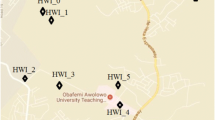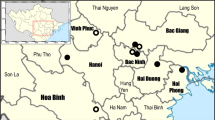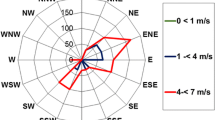Abstract
A comprehensive research of the polycyclic aromatic hydrocarbons (PAHs) emission from domestic waste incinerators in northern areas of Vietnam, were investigated. Sixty-four samples from two domestic waste incinerators were collected and analyzed for PAHs. The PAHs concentrations in the samples were determined using gas chromatography coupled with mass spectrometry. In April, June, September, and November 2021, Σ16PAHs mean concentrations in chimney air samples were 970.9 ± 57.4, 1061.9 ± 49.8, 1070.7 ± 41.3 and 1136.1 ± 136.5 µg m−3, respectively. The mean emission factors of Σ16PAHs were 7.5 mg/kg. The mean percentages of low molecular weight PAHs were predominant in the analyzed air samples. The toxic equivalent quotient of samples ranged from 30.7 to 41.7 mg/kg, whereas the incremental lifetime cancer risk exceeded 10− 3. This results implied a high level of concern with potentially negative health consequences. The four diagnostic ratios of PAHs were found and can be used for identification of sources markers from domestic waste incinerators.



Similar content being viewed by others
References
Abdel-Shafy H, Mansour MSM (2016) A review on polycyclic aromatic hydrocarbons: source, environmental impact, effect on human health and remediation. Egypt J Pet 25:107–123
Al-Harbi M, Alhajri I, Whalen JK (2020) Health risks associated with the polycyclic aromatic hydrocarbons in indoor dust collected from houses in Kawait. Environ Pollut 266:115054
Anh HQ, Tue NM, Tuyen LH, Minh TB, Viet PH, Takahashi S (2019) Polycyclic aromatic hydrocarbons and their methylated derivatives in settled dusts from end-of-life vehicle processing, urban, and rural areas, northern Vietnam: occurrence, source apportionment, and risk assessment. Sci of the Total Environ 672(1):468–478
Anh HQ, Watanabe I, Tue NM, Tuyen LH, Viet PH, Chi NK, Minh TB, Takahashi S (2020) Polyurethane foam-based passive air sampling for simultaneous determination of POP- and PAH- related compounds: a case study in informal waste processing and urban areas, northern Vietnam. Chemosphere 247:125991
Chen Y, Zhao R, Xue J, Li J (2013) Generation and distribution of PAHs in the process of medical waste incineration. Waste Manag 33:1165–1173
Khanal R, Furumai H, Nakajima F, Yoshimura C (2018) Carcinogenic profile, toxicity and source apportionment of polycyclic aromatic hydrocarbons accumulated from urban road dust in Tokyo, Japan. Ecotoxicol Environ Saf 165:440–449
Li HY, Gao PP, Ni HG (2019) Emission characteristics of parent and halogenated PAHs in simulated municipal solid waste incineration. Sci of the Total Environ 665:11–17
Lu JW, Zhang SK, Hai J, Lei M (2017) Status and perspectives of municipal solid waste incineration in China: a comparison with developed regions. Waste Manage 69:170–186
Ministry of natural resources and environment (MONRE) (2015) Circular on the technical procedure for monitoring exhaust gases, Vietnam
National Institute of Occupational Safety and Health (NIOSH) (2003) Hydrocarbons, aromatic: Method 1501. https://www.cdc.gov/niosh/docs/2003-154/pdfs/1501.pdf. Accessed 28 Nov 2019
Oanh NTK, Ly BT, Danutawat TD, Manandhar RB, Prapat P, Simpson CD, Liu LS (2011) Characterization of particulate matter emission from open burning of rice straw. Atmos Environ 45:493–502
Patel AB, Shaikh S, Jain KR, Desai C, Madamwar D (2020) Polycyclic aromatic hydrocarbons: sources, toxicity, and remediation approaches. Front Microbiol 11:562813
Phuong PTH, Nghiem TD, Thao PTM, Nguyen TD (2022) Emission factors of selected air pollutants from rice straw open burning in the Mekong Delta of Vietnam. Atmos Pollut Res 13:101353
Samae H, Tekasakul S, Tekasakul P, Furuuchi M (2021) Emission factors of ultrafine particulate matter (PM < 0.1 µm) and particle-bound polycyclic aromatic hydrocarbons from biomass combustion for source apportionment. Chemosphere 262:127846
Shu WB, Zhao YB, Ni HG, Zeng H (2018) Size-dependent emission characteristics of airborne parent and halogenated PAHs from municipal solid waste incinerator in Shenzhen, China. Chemosphere 192:250–257
United States Environmental Protection Agency (USEPA) (2009) Risk Assessment Guidance for superfund Volume 1: Human Health Evaluation Manual, (Part F, Supplemental Guidance for Inhalation Risk Assessment)- EPA-540-R-070-002. EPA, Washington, DC, USA
Wiriya W, Chantara S, Sillapapiromsuk S, Lin NH (2016) Emission profiles of PM10-bound polycyclic aromatic hydrocarbon from biomass burning determined in chamber for assessment of air pollutants from open burning. Aerosol Air Qual Res 16:2716–2727
Zivancec J, Antic I, Buljovcic M, Durrisic-Mladenovic N (2022) A case study on the occurrence of polycyclic aromatic hydrocarbons in indoor dust of serbian households: distribution, source appointment, and health risk assessment. Chemosphere 295:133856
Acknowledgements
This research is funded by Vietnam National Foundation for Science and Technology Development (NAFOSTED) under grant number “105.08-2020-05”. The authors would like to thank the strong research group ROOM, Environmental and life science research Laboratory, Thuy loi University for their support during the research.
Author information
Authors and Affiliations
Corresponding authors
Ethics declarations
Conflict of interest
The authors declare that they have no conflict of interest.
Additional information
Publisher’s Note
Springer Nature remains neutral with regard to jurisdictional claims in published maps and institutional affiliations.
Rights and permissions
Springer Nature or its licensor (e.g. a society or other partner) holds exclusive rights to this article under a publishing agreement with the author(s) or other rightsholder(s); author self-archiving of the accepted manuscript version of this article is solely governed by the terms of such publishing agreement and applicable law.
About this article
Cite this article
Dung, N.T., Toan, V.D., Mai, N.T. et al. Polycyclic Aromatic Hydrocarbons from Domestic Solid Waste Incinerators in Nam Dinh Province, Northern Area of Vietnam: A Comprehensive Assessment of Emission, Source Markers and Human Health Risk. Bull Environ Contam Toxicol 111, 18 (2023). https://doi.org/10.1007/s00128-023-03774-w
Received:
Accepted:
Published:
DOI: https://doi.org/10.1007/s00128-023-03774-w




